新概念一lesson43-48课文及知识点
- 格式:doc
- 大小:328.50 KB
- 文档页数:3
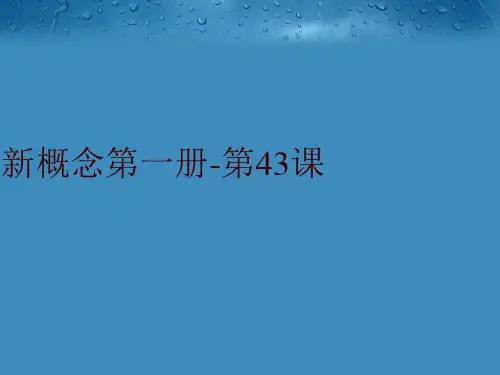
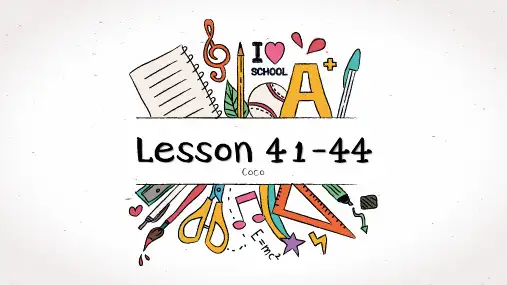
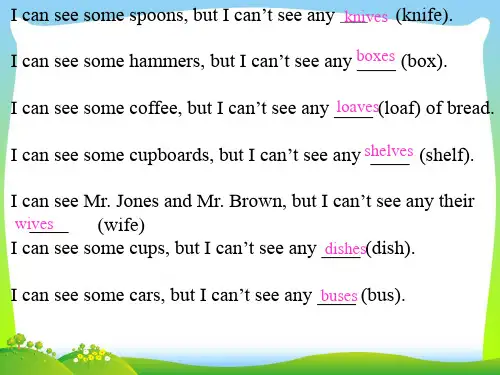
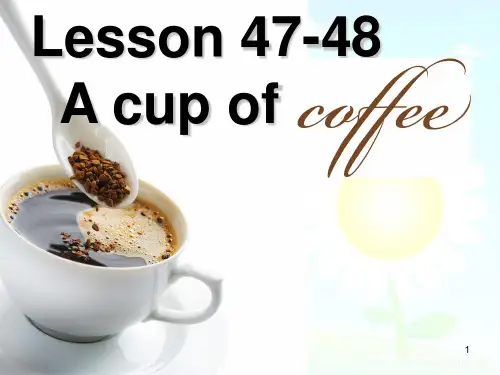
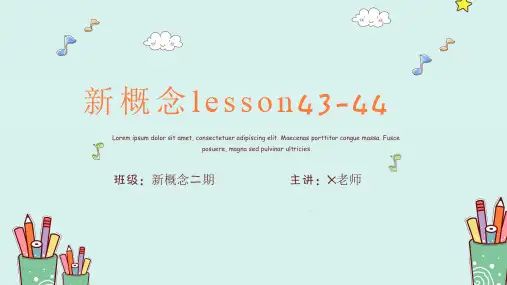
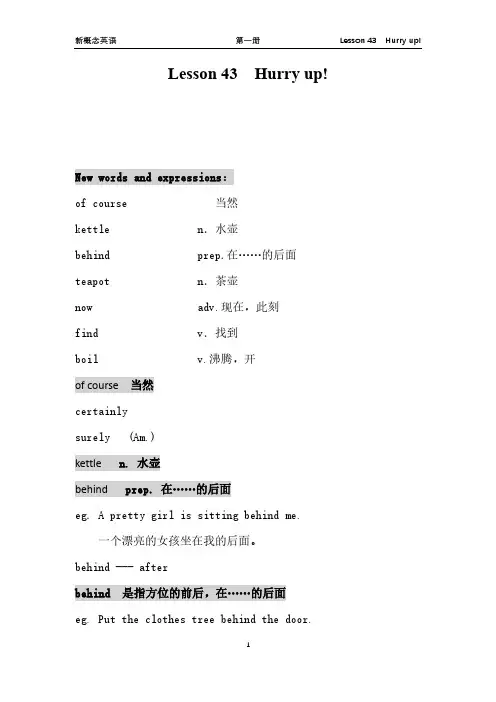
Lesson 43 Hurry up!New words and expressions:of course 当然kettle n.水壶behind prep.在……的后面teapot n.茶壶now adv.现在,此刻find v.找到boil v.沸腾,开of course当然certainlysurely (Am.)kettle n. 水壶behind prep. 在……的后面eg. A pretty girl is sitting behind me.一个漂亮的女孩坐在我的后面。
behind --- afterbehind 是指方位的前后,在……的后面eg. Put the clothes tree behind the door.把衣架放在门后。
after 是指时间或顺序的先后,在……之后。
eg. She came after me. 她在我之后来的。
in front of <--> beforein front of指方位的前后,是behind 的反义词,表示在……之前。
eg. There is a tree in front of the house.在房子前面有一棵树。
before 指时间或顺序的先后,是after的反义词,表示在……之前。
eg. You must come here before six o'clock.你必须在六点钟之前来到这里。
eg. A pretty girl is sitting behind me.一个漂亮的女孩坐在我的后面。
teapot n.茶壶kettle n.水壶now adv.现在,此刻(现在进行时)eg. They are doing their homework now.他们正在做作业。
eg. Is he cooking a meal now? 他现在正在做饭吗?find v. 找到(结果)eg. I can't find my watch. 我找不到手表了。
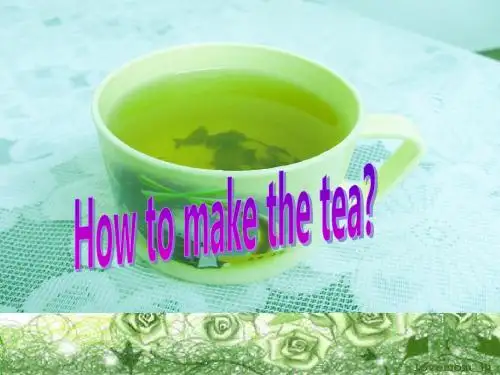
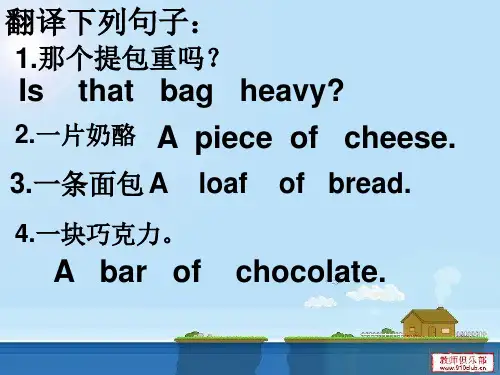
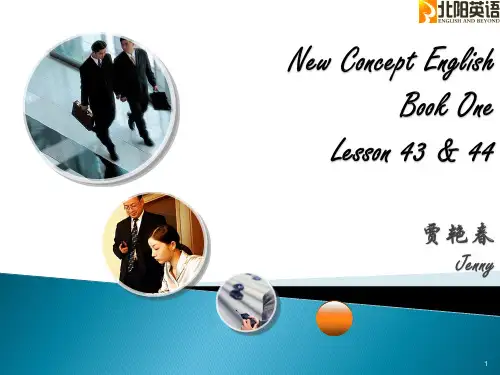
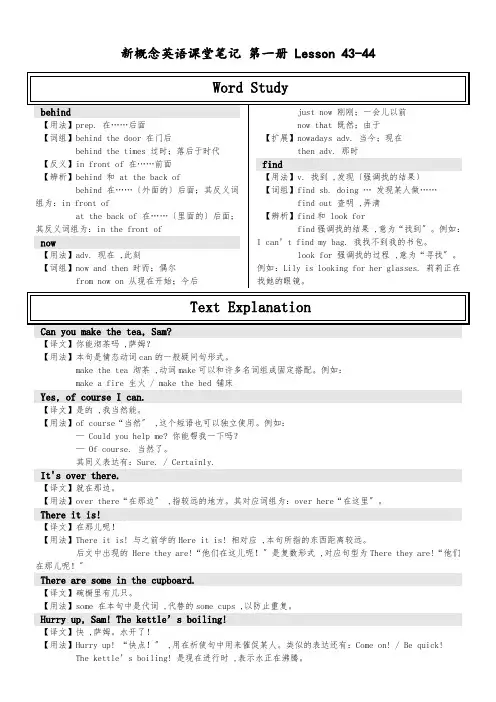
新概念英语课堂笔记第一册 Lesson 43-44【译文】你能沏茶吗 ,萨姆?【用法】本句是情态动词can的一般疑问句形式。
make the tea 沏茶 ,动词make可以和许多名词组成固定搭配。
例如:make a fire 生火 / make the bed 铺床Yes, of course I can.【译文】是的 ,我当然能。
【用法】of course“当然〞 ,这个短语也可以独立使用。
例如:— Could you help me? 你能帮我一下吗?— Of course. 当然了。
其同义表达有:Sure. / Certainly.It's over there.【译文】就在那边。
【用法】over there“在那边〞 ,指较远的地方。
其对应词组为:over here“在这里〞。
There it is!【译文】在那儿呢!【用法】There it is! 与之前学的Here it is! 相对应 ,本句所指的东西距离较远。
后文中出现的 Here they are!“他们在这儿呢!〞是复数形式 ,对应句型为There they are!“他们在那儿呢!〞There are some in the cupboard.【译文】碗橱里有几只。
【用法】some 在本句中是代词 ,代替的some cups ,以防止重复。
Hurry up, Sam! The kettle’s boiling!【译文】快 ,萨姆。
水开了!【用法】Hurry up! “快点!〞 ,用在祈使句中用来催促某人。
类似的表达还有:Come on! / Be quick!The kettle’s boiling! 是现在进行时 ,表示水正在沸腾。
【介绍】can是英语中最常用的几个情态助动词之一 ,它本身不表示动作 ,只表示体力或脑力方面的能力或客观可能等 ,还可以表示“请求〞和“允许〞。
它必须与其他动词原形连用 ,本身没有人称和数的变化。
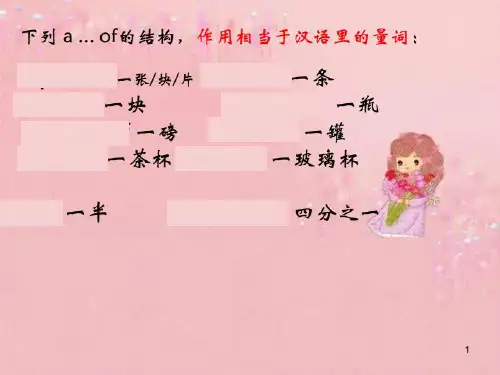
新概念4344 课1 of course 当然了= certainly2 kettle n. 水壶3 teapot n. 茶壶3 复习:外部:in front of 在…前面behind 在…后面at the back of 在… 后面内部:in the front of 在…前面at the back of 在… 后面4 now = at the moment = at present 目前,此刻,引导现在进行时(be doing)5 find v. 找到Look for v. 寻找(强调过程)find v. 找到(强调结果)e.g. I _look for_ my lost pen but I can’t _find_ it.( find , look for)6 boil vt. 煮… , 使..沸腾vi. 烧开,boil water 煮水,烧水boiling water n. 沸水boiled water n. 凉白开3、some和any(一些)1)some一般用于肯定句,any用于否定句和疑问句2)在表示请求、建议、征求意见等委婉语气的问句中,用some而不用any Can you bring some things to school?你能带些东西到学校吗?2 over there 在那边over here 在这边1) Of course (当然了) = CertainlyCan I borrow your book? > Of course! (我可以借你的书吗?> 当然可以!)2) Kettle (水壶) vs Teapot (茶壶)Please boil some water in the kettle. (请在水壶里煮开一些水。
)Let's brew some tea in the teapot. (让我们在茶壶里泡一些茶。
)3) 复习:外部位置:in front of (在...前面) | behind (在...后面)内部位置:in the front of (在...前面) | at the back of (在...后面)The car is parked in front of the house. (汽车停在房子前面。
新概念一l e s s o n43-48课文及知识点(总3页)-CAL-FENGHAI.-(YICAI)-Company One1-CAL-本页仅作为文档封面,使用请直接删除《新概念英语》第一册第43课Hurry up! 快点!【课文】PENNY: Can you make the tea, Sam SAM: Yes, of course I can, Penny.SAM: Is there any water in this kettle PENNY: Yes, there is.SAM: Where's the teaPENNY: It's over there, behind the teapot. PENNY: Can you see itSAM: I can see the teapot, but I can't see the tea. PENNY: There it is! It's in front of you!SAM: Ah yes, I can see it now.SAM: Where are the cupsPENNY: There are some in the cupboard. PENNY: Can you find themSAM: Yes. Here they are.PENNY: Hurry up, Sam! The kettle's boil ing!【课文翻译】彭妮:你会沏茶吗,萨姆萨姆:会的,我当然会,彭妮。
萨姆:这水壶里有水吗彭妮:有水。
萨姆:茶叶在哪儿彭妮:就在那儿,茶壶后面。
彭妮:你看见了吗萨姆:茶壶我看见了,但茶叶没看到。
彭妮:那不是么!就在你眼前。
萨姆:噢,是啊,我现在看到了。
萨姆:茶杯在哪儿呢彭妮:碗橱里有几只。
彭妮:你找得到吗萨姆:找得到。
就在这儿呢。
彭妮:快,萨姆。
水开了!Lesson 45The boss's letter 老板的信THE BOSS: Can you come here a minuteplease, BobBOB: Yes, sirTHE BOSS: Where's PamelaBOB: She's next door.She's in her office, sir.THE BOSS: Can she type this letter for meAsk her please. BOB: Yes, sir.BOB: Can you type this letter for the boss please, PamelaPAMELA: Yes, of course I can.BOB: Here you are.PAMELA: Thank you, Bob.PAMELA: Bob!BOB: Yes What's the matter.PAMELA: I can't type this letter.PAMELA: I can't read it!The boss's handwriting is terrible!参考译文老板:请你来一下好吗鲍勃鲍勃: 什么事,先生老板:帕梅拉在哪儿鲍勃: 她在隔壁,在她的办公室里,先生。
老板:她能为我打一下这封信吗请问她。
鲍勃: 好的,先生。
鲍勃: 请你把这封信给老板打一下可以吗,帕梅拉帕梅拉:可以,当然可以。
鲍勃: 给你这信。
帕梅拉:谢谢你,鲍勃。
帕梅拉:鲍勃!鲍勃: 怎么了怎么回事帕梅拉:我打不了这封信。
帕梅拉:我看不懂这封信,老板的书写太糟糕了!lesson 47MRS YOUNG: Do you like coffee, Mrs PriceMRS PRICE: Yes, I do.MRS YOUNG: Do you want a cupMRS PRICE: Yes, please. Mrs Young.MRS YOUNG: Do you want any sugarMRS PRICE: Yes, please.MRS YOUNG: Do you want any milkMRS PRICE: No, thank you. I don't like milk in my like blackcoffee.MRS YOUNG: Do you like biscuitsMRS PRICE: Yes, I do.MRS YOUNG: Do you want oneMRS PRICE: Yes, please.参考译文克里斯廷:你喜欢咖啡吗,安安:是的,我喜欢。
克里斯廷:你想要一杯吗安:好的,请来一杯,克里斯廷。
克里斯廷:你要放些糖吗安:好的,请放一些。
克里斯廷:要放些牛奶吗安:不了,谢谢。
我不喜欢咖啡中放牛奶,我喜欢咖啡。
克里斯廷:你喜欢饼干吗安:是的,我喜欢。
克里斯廷:你想要一块吗安:好的,请来一块。
Lesson43--48课1 of course [əv'kɔ:s] 当然2 kettle ['ketl] n.水壶3 behind [bi'haind] prep.在…后面4 teapot ['ti:pɔt] n.茶壶5 now [nau] ad.现在,此刻6 find [faind] v.找到7 boil [bɔil] v.沸腾,开 8 can [kæn] 能够 9boss [bɔs] n.老板,上司10minute ['minit, mai'nju:t] n.分(钟)11 ask [ɑ:sk] v.请求,要求12 handwriting['hændˌraitiŋ] n.书写13 terrible ['terəbəl] a.糟糕的,可怕的14 lift [lift] v.拿起,搬起,举起15 cake [keik] n.饼,蛋糕 16 biscuit ['biskit] n.饼干17 like [laik] v.喜欢,想要 18want [wɔnt, wɑ:nt] v.想 19 fresh [freʃ] a.新鲜的 20 egg[eg] n.鸡蛋21 butter ['bʌtə] n.黄油22 pure [pjuə] a.纯净的23 honey ['hʌni] n.蜂蜜24 ripe [raip] a.成熟的25banana [bə'nɑ:nə] n.香蕉26 jam [dʒæm] n.果酱27 sweet [swi:t] a.甜的28 orange ['ɔrindʒ] n.橙29 Scotch whisky苏格兰威士忌30 choice [tʃɔis] a.上等的,精选的31 apple ['æpəl] n.苹果32wine [wain] n.酒,果酒33 beer [biə] n.啤酒34 blackboard ['blækbɔ:d] n.黑板II 词组 1make the tea 的意思是沏茶,2 hurry up! 快一点!3over there 在那儿 4next door 隔壁 5 in this kettle 在水壶里 6 in the cupboard 在橱柜里 6can 能,会 can 后加动词原形,变否定在can 后加not ,变疑问将can 提前。
7. find 找到,强调找的结果; look for 寻找,强调找的动作。
在....后边 ---反义词 in front of 在。
前面 = at the moment 此刻,现在 10 ask:1) 问 ask a question 问一个问题 2)让,要求 ask Sb to do Sth 让某人做某事 11 lift:1)举起,搬起,拿起 lift that chair 举起那把椅子 2)电梯 3)give Sb a lift 搭便车 12:come here a minute 过来一会 13 in her office 在她的办公室 14type this letter for Sb 为某人打这封信 15.like 喜欢 like to do Sth (偶尔)喜欢做某事 I like to play football this Sunday. like doing Sth(长期)喜欢做某事 I like playing football on Sundays 想 want to do Sth 想要做某事 I don’t want to do Sth 。
我不想做某事 want Sth 想要某物 你想要一些糖吗 Do you want any sugar =Would you like some sugar 17 a cup of coffee 一杯咖啡milk in my coffee 在咖啡里加牛奶white/black coffee 清/加奶 III 重点句型: 1Can you make the tea 你会沏茶吗 Yes,of course I can.=Yes,I certainly can.=Sure. 是的,我当然会。
2 Is there any water in this kettle Yes, there is. 水壶里有水吗是的,有。
3Can you see it I can see the teapot, but I can’t see the tea. 你能看见它吗我能看见茶壶,但是我没看到茶叶。
4Can you find them 你能找到他们吗 5 Can you come here a minute please 你能过来一下吗 6Can she type this letter for me 她能为我打这封信吗 7 I can’t read it. 我看不懂这封信。
8 I can’t type this letter. 我不能打这封信。
9Can you type this letter for the boss 你能为老板打这封信吗 10What’s the matter (with…)=What’s wrong(with…)=What’s up(with…) (……)怎么了11一般疑问句:Do you like any+ 可数名词复数/不可数名词 你喜欢一些.......吗 肯定回答:Yes, I do. 是的,我喜欢。
/否定回答:No, I don’t.不,我不喜欢。
肯定句:I like some+ 可数名词复数/不可数名词. 我喜欢一些。